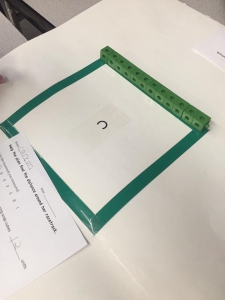Another exciting day of job-embedded learning with students and educators in a primary class. The teacher had just introduced her students to perimeter the day before. – “estimate, measure, and record the distance around objects, using non-standard units”. The students were organized into pairs and given a shape and snap cubes (see photo) to measure and record the perimeter. The teacher had chosen to use this manipulative because they could be snapped together to form the length of one side. Some students used what they knew about two-dimensional shapes and recognized that they did not have to measure all of the sides if some were the same length. What a wonderful opportunity to model multiplicative thinking (proportional reasoning)! If one side of a square is 12 snap cubes the total of “4 groups of 12” is the perimeter.

This lesson provided a wonderful opportunity to observe students as they measured and calculated (formative assessment). Tomorrow they will work with the same shapes and use different non-standard units. During the consolidation part of the lesson at the end we stressed the importance of always including the unit of measure with the number as “the unit chosen determines the value of the measurement”. Big Idea – If you use a bigger unit, you need fewer of them to measure the same length. For example: 1 metre = 100 centimetres.
I suggested to the teacher that she have her students use cuisenaire rods to measure with next time. Cuisenaire rods lend themselves nicely to linear measurement.
Some questions to think about:
- Would they choose all of the same rods to measure their shape with?
- What happens to the numerical value if they measure the same shape first with orange rods and yellow rods the next time?
- Would the white or red rod be appropriate for a big shape or would it be better to use a longer rod like the blue or orange?
Once again, today the focus was on Measurement, but look at how Number Sense & Numeration and Geometry were naturally embedded in the lesson. As I like to say, “Bonus!”

